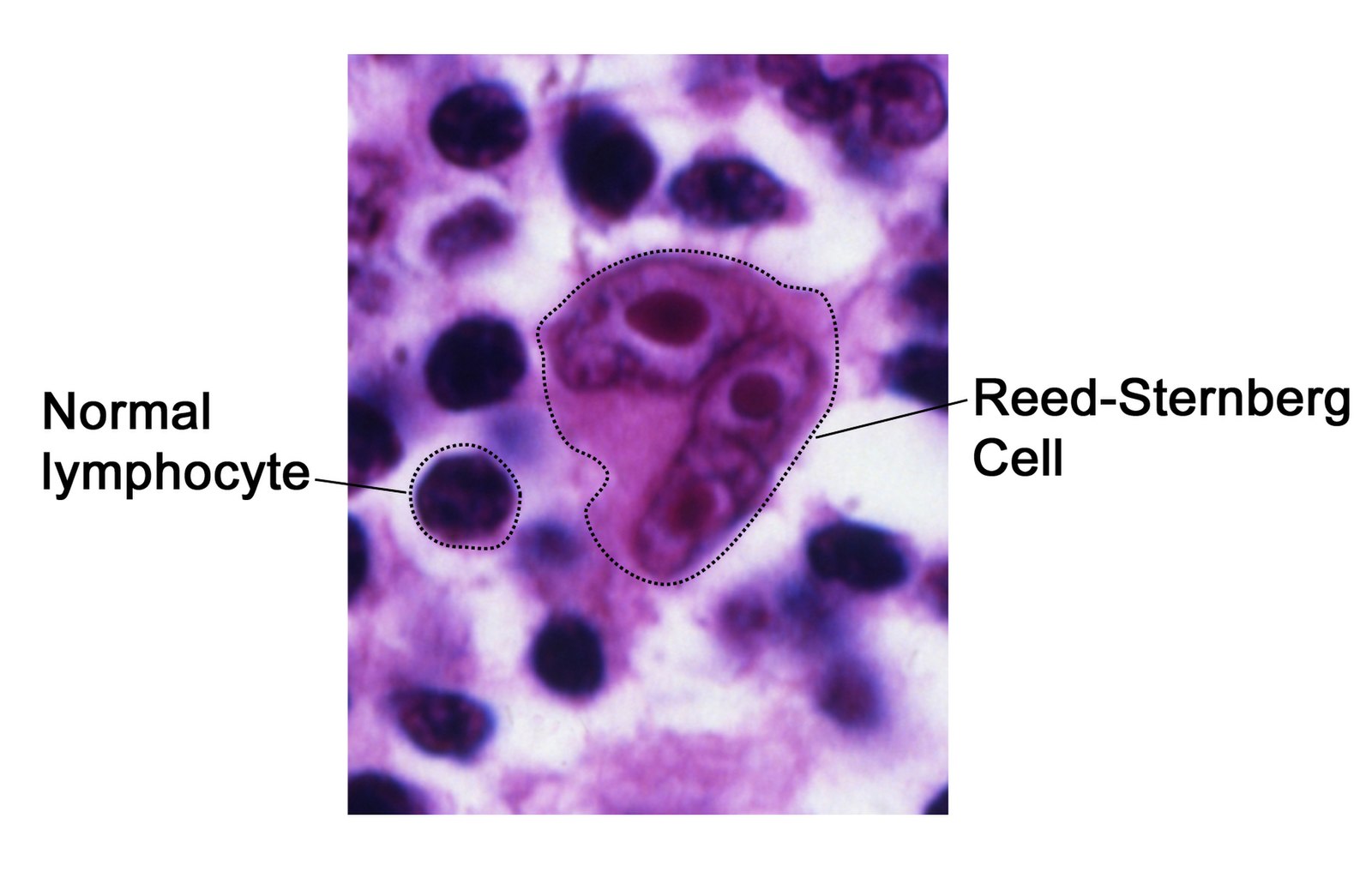Lymphoma is a type of cancer arising from B cell lymphocytes that usually circulate in the lymphatic system and grow within lymph nodes. There are two main types – Hodgkin’s lymphoma and non-Hodgkin’s lymphoma.
Risk Factors
- Epstein-Barr (EBV) infection
- Autoimmune diseases e.g. Reumatoid arthritis, coeliac disease, SLE
- Immunosuppression e.g. drugs, history of organ/stem cell transplant, HIV
- Family history
- Cigarette smoking
Pathophysiology
- Hodgkin’s lymphoma is a cancer derived from B cell lymphocytes
- The diagnostic feature of Hodgkin’s lymphoma is the presence of the Reed-Sternberg cell histopathologically. These are abnormal, large, neoplastic cells with two large nuclei which look like owl eyes.
- The underlying pathophysiology is poorly understood for Hodgkin’s lymphoma, but one theory suggests Reed Sternberg cells form from pre-apoptotic B cells which evade programmed cell death.
- Reed Sternberg cells are thought to be able to secrete various cytokines, growth factors and chemokines that allows them to recruit other cells and form a specific microenvironment. This microenvironment in turn likely helps support survival of these cells as well as helping evade anti-tumour immune mechanisms.
Unknown authorUnknown author, Public domain, via Wikimedia Commons
Reed Sternberg Cell
Clinical Features
- Painless lymphadenopathy: These can be anywhere in the body, including the cervical region, axilla, inguinal region etc. They usually feel rubbery on palpation.
- B Symptoms:
- Fever: This can be in the form of the Pel Ebstein fever which is a few days of high fever alternating with days/weeks of normal temperature
- Drenching night sweats
- Unexplained weight loss
- Loss of appetite
- Pruritus
- Fatigue
- Alcohol Induced Lymph Node Pain
- Mediastinal mass effects (from enlarged mediastinal lymph nodes)
- Chest pain
- Cough
- Shortness of breath
- Age: Hodgkin Lymphoma has a bimodal distribution in that it affects younger people (15-39) and older adults (>75 years)
Investigations
Bloods
- FBC: WCC can be high or low. A low haemoglobin suggests high cell turnover and is a poor prognostic indicator.
- LDH: Often raised in Hodgkin’s lymphoma but this isn’t specific as it can go up in other conditions as well
- LFT: May be deranged if there is hepatic involvement
- ESR: May be raised
- Blood film: To visualise Reed-Sternberg cells
Imaging
- Chest X ray
- Masses
- Mediastinal lymph nodes
- CT Thorax, Abdomen and Pelvis
- Staging scan
- Involvement of lymph nodes in the chest, abdomen, or pelvis.
- Shows distant metastasis to liver, lungs etc
- PET Scan
Special Tests
- Biopsy of lymph nodes to visualise Reed-Sternberg cells
Differential Diagnosis
- Reactive lymphadenopathy: Usually painful, may be associated with recent viral illness
- Infectious mononucleosis
- Lymphadenopathy from another malignancy e.g. breast cancer
- Non-Hodgkin’s lymphoma
Staging
The Ann Arbor system is used to stage lymphoma.
- I: Confined to 1 area of lymph nodes
- II: 2 or more nodal areas involved but on the same side of the diaphragm
- III: Involvement of nodes on both sides of the diaphragm
- IV: Spread beyond lymph nodes e.g. liver
Each stage is associated with either A or B.
A = No systemic symptoms other than itching
B = Weight loss >10% in 6 months, unexplained fever >38, or night sweats (the presence of B symptoms)
Management
Chemotherapy and radiotherapy are the mainstay of treatment for Hodgkin’s lymphoma.
The main chemotherapy regimen used is the ABVD regimen of Adriamycin/Bleomycin/Vinblastine/Dacarbazine.
Prognosis
Prognosis varies depending on many factors including disease stage. Stage 1 is thought to have a 5-year survival of 90%, whilst stage 4 having a 70% 5-year survival rate. These numbers vary based on source.
References
https://www.msdmanuals.com/en-gb/professional/hematology-and-oncology/lymphomas/hodgkin-lymphoma#v975458
https://www.pathologyoutlines.com/topic/lymphomanonBclassic.html
https://www.ncbi.nlm.nih.gov/books/NBK499969/
https://www.nature.com/articles/s41375-021-01204-6
https://www.cdc.gov/cancer/lymphoma/index.htm
https://www.cancerresearchuk.org/about-cancer/hodgkin-lymphoma/survival
